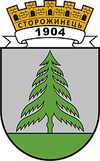Storoschynez
| Storoschynez | ||
| Сторожинець | ||

|
|
|
| Basic data | ||
|---|---|---|
| Oblast : | Chernivtsi Oblast | |
| Rajon : | Storozhynets district | |
| Height : | 366 m | |
| Area : | 5.8 km² | |
| Residents : | 14,506 (2007) | |
| Population density : | 2,501 inhabitants per km² | |
| Postcodes : | 59000 | |
| Area code : | +380 3735 | |
| Geographic location : | 48 ° 10 ' N , 25 ° 43' E | |
| KOATUU : | 7324510100 | |
| Administrative structure : | 1 city | |
| Mayor : | Iryna Porajko | |
| Address: | вул. Грушевського 6 59000 м. Сторожинець |
|
| Statistical information | ||
|
|
||
Storoschynez ( Ukrainian Сторожинець ; Russian Сторожинец / Storoschinez , German Storozynetz , Romanian Storojineț , Polish Storożyniec ) is a district capital in the Ukrainian Chernivtsi Oblast . It is located about 22 km southwest of Chernivtsi on the left bank of the Sereth in the northern part of Bukovina, which today belongs to Ukraine .
history
The city was mentioned in writing for the first time in 1448 and belonged to the Principality of Moldova until 1774 , then to the Habsburg Monarchy until 1918 , and from 1849 in the crown land of Bukovina. In 1854 the place was granted market rights, and since 1904 also full city rights as the district capital with the seat of a district administration and a district court. In 1886 the railway line Hliboka - Berhomet on Sereth was opened with a train station in the village, which still exists today.
After the end of the First World War , the city became part of Romania (in Storojineț County ). In the course of the annexation of northern Bukovina on June 28, 1940, it became part of the Soviet Union (between 1941 and 1944 it became part of Romania) and has been part of Ukraine since 1991.
In Storoschynetz, the Jews together with the German residents made up about half of the city's population, the other half consisted mainly of Romanians and Ukrainians. In the 1930 census, when the proportion of the German-speaking population had already fallen in favor of Romanian, of the approximately 8,700 inhabitants of the city, 36.4% gave Romanian, 19.6% Yiddish, 17.4% German, 13.6% Ukrainian and 10.4% use Polish as their mother tongue. The Jewish population already decreased under Romanian rule, the majority were then deported and murdered between 1941 and 1943 .
Daughters and sons of the city
- Alfred Margul-Sperber (1898–1967), poet
- Theodor von Flondor (1862–1908), musician and conductor



